Section 2:
ATHABASCANS
5-7 days
OBJECTIVES
1. Students define the term
"Athabascan" (as it refers to both a group of languages and to the
people who speak the languages)
2. Students know how many Alaskan Athabascan languages there
are
3. Students can name at least two Alaskan Athabascan languages
4. Students can name at least 10 specific adaptations which
Athabascans have made in the past.
MATERIALS
1.Student text, Alaskan
Athabascans
2. Native language tapes from University of Alaska library
(enrichment)
3. 1 copy Needzeek (enrichment)
4. Handouts 1 and 2
5. UN 621 Alaska History (enrichment)
6. Worksheets II, III & IV
7. 2 sets Athabascan Artifact Cards
8. 10 sets Data sheets
9. Upper Tanana House Poster
10. Quiz 2
PREPARATION
1. Invite an Athabascan-speaking
resource person to class (enrichment)
2. Read Appendix A in this guide for information about Athabascan
cultures
3. Make copies of Handouts 1 & 2 and Worksheets II, III, IV
& Quiz 2 (1 per student)
4. Order UN 621 or other materials avail-able in ASD AVS Center
(enrichment)
5. Prepare any centers you desire (sug-gestions follow)
6. Tack up Upper Tanana House Poster
ACTIVITIES
1. Read and discuss Chapter III
in Alaskan Athabascans
2. Listen to a tape or a speaker of one or more Athabascan
languages (enrichment)
3. Study the Native Peoples and Languages of Alaska map
4. Word Find Puzzle (Worksheet II)
5. Alaska Map (Worksheet III)
6. Classify Athabascan Artifact Cards
7. Worksheet IV
8. Enrichment activities with Athabascan Artifact Cards
9. Enrichment: using other materials available in ASD AVS
Center
10.Read about Bering Land Bridge (enrichment)
11.Quiz 2
New Vocabulary:
Athabascan
Upper Tanana
Tanana
Ahtna
Kutchin
Holikachuk
Tanaina
Ingalik
Han
Koyukon
Upper Kuskokwim
Tanacross
CONCEPT: there ARE 11 ALASKAN
ATHABASCAN GROUPS
This section of the unit will center on helping students to
assimilate information on Athabascans and on map
work.
READ TEXT: CHAPTER III IN ALASKAN
ATHABASCANS
First, have students read Chapter III in their texts. Review with
them what they have read.
CHAPTER III
Athabascans
If you are an Athabascan
Indian, you are one of about 200,000 people in North America.
There are more Athabascans than any other American Indian group.
In Alaska alone there are about 6,400 Athabascans, and there are
also Athabascan groups in Canada, California, and the American
Southwest. But what does the word Athabascan mean?
The word "Athabascan" is used to
talk about a group of languages which were once, thousands of
years ago, the same language. Over the years people moved away
from each other and their languages started to become different.
At first, just the accents were different--something like the
difference between a Southern accent and an English accent. But
people were so far apart that they never talked to each other, and
slowly different
DISCUSSION
Discuss what the Athabascan areas have in common. Speculate on
why most Athabascan settlements are located on rivers. Discuss the
types of food and shelter students expect people to use in the
Athabascan areas of Alaska. NOTE: Although water travel and fishing
have probably always been important to Athabascans, the
settlements
words took on different
meanings, or the words themselves changed. For instance, the word
for "gloves" became "gech" for one group of people and "gis" for
another group of people. Through the years the differences between
the two groups became greater and greater until people in one area
could no longer understand people in another area. Whenever that
happens, we say that the two groups of people speak different
languages.
That is what happened to the
Athabascan language. Today there are eleven Athabascan languages
in Alaska alone: Ahtna, Tanaina (also spelled Denaina),
Holikachuk, Koyukon, Upper Kuskokwim, Tanana, Tanacross, Upper
Tanana, Han, Kutchin (more correctly spelled "Gwich'in"), and
Ingalik (more correctly Deg Hit'an). There are other Athabascan
languages in Canada. And there are two well known Athabascan
languages in the American Southwest: Apache and
Navajo.
The word "Athabascan" is used
to talk about both the languages and the people who speak (or
whose ancestors spoke) that language. The name "Athabascan"
originally came from the large lake in Canada called "Lake
Athabasca". The lake was given its name by the Cree Indians, who
lived east of it. In Cree, "Athabasca" means "grass here and
there", and described the lake. The name was also used to talk
about the Indian groups that lived west of the
lake.
You can see on the language
map of Alaska that the area inhabited by Athabascans is one of the
largest of the Native areas in the state. The area is all inland,
except for the part around Cook Inlet. Find the Athabascan
settlements on the map. You can see that most of them are located
on rivers, what needs can you think of that rivers might help
fulfill?
DISCUSSION (cont.)
were traditionally located on small tributaries rather than major
rivers. Fishing was done by means of a weir or traps, both useless
methods on the Yukon. The move to major rivers occurred as a result
of Gold Rush trade above the river and the permanent settlement of
people into villages after schools were established in the
interior.
LEARN ABOUT YOUR STUDENTS
Are there Athabascan students in your class? If so, ask them where
their families are originally from. Have them find their ancestral
homes on the Native Peoples and Languages of Alaska map and mark
them. Learn what Athabascan language is spoken there. If their
parents speak the language, try to arrange for a classroom visit by
the parents.
ENRICHMENT OR LEARNING CENTER:
LANGUAGES
Check out any one of many Athabascan language cassette tapes recorded
in 1972-73 as part of the Alaska Native Oral Language Project. The
tapes are available from the University of Alaska library or the
Alaska State Library. One good tape is #204, "Man in the Moon" told
by David Salmon in English and Kutchin. Make the tape available for
students to listen to. Make a checklist for students which might
include the following items:
1. What languages are spoken
on this tape?
2. Locate the Athabascan language on a map of Alaska.
3. David Salmon is from Chalkyitsik. Find it on the map.
4. Read Needzeek, an Upper Tanana story. Compare the two stories.
(Needzeek should be in your school library; it is also part of UN
601, Athabascan Social Studies, available in the ASD AVS
Center.)
5. Why do you think the stories are different?
MAP WORK
DISCUSSION AND REVIEW
Next, begin an extensive study of the Native Peoples and Languages
of Alaska map. The following strategies might be
followed:
1. Have a student identify Anchorage's
location on the map. Mark it with a pin. Ask students to locate their
home towns, if they have moved to Anchorage from other parts of
Alaska. Mark those areas on the map also.
2. Ask students to use the information
they have just read in their texts to locate the Athabascan area on
the Language Map. What color family represents the Athabascan area?
They should be able to tell you that the Athabascan territories are
in shades of pink. You might briefly note the other colors which
relate to other Native groups as well: Eskimo languages are in shades
of blue; Aleut is green; Tlingit is brown; Haida is purple; and
Tsimshian is Kelly green.
3. Now concentrate on the Athabascan
area. Point out the major river systems that run through that area:
the Yukon- Tanana- Porcupine- -Koyukon System, Copper River, the
Susitna River, and the Upper Kuskokwim River.
4. Now point out that the Athabascan area
is subdivided into eleven smaller areas, with each area being colored
a slightly differ-ent shade of pink. Note that whereas there is a
heavy white line around the entire Athabascan area, there are thinner
white lines around each separate shade. Ask students what each shade
represents. Refer them to their reading. They should be able to tell
you that each shade represents one of the eleven Athabascan
languages.
There are also dotted white lines within
some of the language areas. You need not cover these with the class
unless they ask. They refer to dialects within a language. Recall
that a dialect is something like an accent, and that dialects are
close enough to each other so that people speaking different dialects
can still understand each other. People speaking different languages,
on the other hand, cannot understand each other.
5. Review the concept of language family,
which was mentioned in the student text. You might inform students
that English, too, is in a language family called "Indo-European".
Most of the European and Indian (i.e., from India, not American
Indian) languages are within that family. Ask students if they can
remember what that tells them about the relationship between English
and French, for instance.
The answer: they were once the same
language, which was differ-ent from both languages, and have diverged
through the centuries.
Similarly, the eleven Athabascan
languages were also at one time a single language. Ask students, "How
do you think it happened that the languages separated from each
other?"
6. Point out the Table of Language Groups
on the middle left side of the map. Alert students to the fact that
the eleven languages are listed (along with a twelfth, Eyak, which is
closely related to Athabascan but which is not itself Athabascan) in
that key, along with the colors that represent them. Although the
students in the back of the room will not be able to see the numbers,
mention them to the class. Explain that those numbers tell how many
people there are in each of the eleven Athabascan groups.
DESK MAPS
Now distribute the desk maps (Handout #1) and Pronunciation Key
(Handout #2) to students. Ask a quick series of questions to
stimulate students to study the map. For instance,
1. Which Athabascan area is next to
the ocean?
2. In which Athabascan area is Fairbanks located?
3. In which Athabascan area is Anchorage located?
4. Which Athabascan area extends farthest north?
5. Which Athabascan area extends farthest west?
Now, together as a class, pronounce the
eleven language names. You might have students color in their desk
maps to correspond with the colors on the Language Map. Students who
need additional help could be aided in making jigsaw puzzles out of
their colored maps. Glue cardboard or construction paper to the back
of the map before cut-ting along the language boundaries.
ENRICHMENT: CLOSER MAP STUDY
If you feel your students need or desire more work with the map, have
them more closely investigate the large wall copy of the Language
Map. Give each group or individual a list of questions, the answers
of which are to be found on the map. You will need to stagger work on
this task so that only three to four students are at the map at a
time.
Sample questions might be:
a. Pick a language. Write it down.
b. Tell the population of that language group.
c. Tell how many people speak the language today.
d. Tell the names of the villages or communities within that language
area.
e. Tell what rivers (if any) the villages are located
on.
WORKSHEETS II AND III
Now distribute Worksheets II and III. Worksheet II can be done in
small groups, and will require that you allow students to go to the
large wall map to find some of the answers. This might be assigned as
a homework or extra-time activity so that students' visits to the
wall map will be staggered. Or, you might have part of the class work
on this activity while the rest works on activities dealing with the
Athabascan Artifact Cards (suggestions follow).
Students should be allowed to use their
desk maps and the wall map in completing both worksheets.
SOME ATHABASCAN ADAPTATIONS: ARTIFACT
CARDS, DATA SHEETS, UPPER TANANA HOUSE POSTER
The Athabascan Artifact Cards and Upper Tanana House Poster
pro-vide examples of some specific adaptations which Athabascans
tradi-tionally made to their environment. There are 16 different
artifact cards, and each class should have two sets. Activities in
which students use the cards should be done in small groups of up to
six students. Therefore, up to twelve students might do the following
activities at the same time. You might have some students working
with the cards while others are finishing up some of the Language Map
ac-tivities described on the preceding pages.
Because the whole class will not be doing
the following activities at the same time, you might want to set up a
center containing the cards, the poster, and the Data Sheets. Or, you
might want to write up directions for students to follow rather than
to verbally explain their tasks.
DEFINE ARTIFACT
Before involving students with the cards, define the word "artifact".
Explain that anything human-made is an artifact - not just those
things which have been favored by archaeologists. Ask for examples of
artifacts from your classroom. Pencils, blackboards, even clothing
would be considered artifacts.
WARM-UP
The first small-group activity with the cards is a warm-up exer-cise
which entails finding the various items pictured on the cards in the
Upper Tanana House Poster. Students needn't write anything at this
stage; they should merely cooperate to find an example of each card's
item somewhere in the poster picture.
CLASSIFICATION EXERCISE
Second, have students perform a classification exercise. The group is
to classify the sixteen artifact cards according to the needs which
each item pictured helps to fulfill. Students may use the Data Sheets
to find out what the item were used for. Tell them that there may be
different ways of classifying the cards, but that their group must
come up with a way that is satisfactory to all members. Have them
record the categories on a piece of paper. When all student groups
have had a chance to do this exercise, ask for the classification
schemes and compare them. Have the students explain why they placed
the item where they did. Stress that there is not a single correct or
incorrect way to do this.
HOUSE POSTER
Third, have students look closely at the Upper Tanana House Poster.
Ask each group to write a paragraph about that poster including at
least the following information, and any more you feel is
important:
a. This house was built in the Upper
Tanana Athabascan area. Find it on the map of Alaska and be prepared
to show the rest of the class where it is.
b. What materials were used in making this house?
c. How is this house adapted to cold winters? Name as many ways as
you can.
WORKSHEET IV
Worksheet IV may be filled in individually or in the same small
groups that were involved in the group activities described on the
pre-ceding pages. Each student should fill out his own worksheet, but
re-search may be a joint effort. Distribute the ten sets of Data
Sheets as you see fit, or leave them at the center for students to
work on at various times throughout the day.
An alternate approach to Worksheet IV is
to divide up the 18 questions among student groups, assigning each
group five of the ques-tions to answer. In a class report session,
groups report their answers and other students are responsible for
learning the answers from them. This method will take less time, but
will also tend to decrease the students' overall knowledge of the
subject.
ENRICHMENT: ARTIFACT CARDS
Students might invent a card game (Concentration, for instance) using
the two sets of Artifact Cards together, in which students must name
both the item and something about it in order to win.
For a writing assignment shuffle the
Artifact Cards and distri-bute the top four to a student. Have the
student write a short story using those four items. In an oral
language exercise, have students sitting in a circle. The first
student is given the top card. He or she must then tell an anecdote
or short story mentioning that item. He or she may then give another
card to the next student in the circle, who then tells a short
anecdote of his own.
When all manipulative activities with the
cards have been completed, students might tack the cards onto the
wall next to the Language Map or Upper Tanana House Poster, linking
with yarn the ob-jects and their places of origin or positions on the
poster.
ENRICHMENT: ADDITIONAL
MATERIALS
Other materials pertinent to Athabascan adaptations are available in
the district and might be checked out at this time. They include F
2035 The Birch Canoe Builder, UN 487 Athabascan Stories, UN 515
Athabascan Caribou Hunt Kit, UN 594 Traditional Alaska Native
Transportation Kit, UN 601 Athabascan Social Studies Unit, and UN 647
Alaska Natives at the Turn of the Century.
ENRICHMENT: BERING LAND BRIDGE
UN 621, Alaska History, consists of a classroom set of books on
Alaska History written at a 5th to 6th grade level. The first chapter
details the Bering Land Bridge theory, which would fit in well at
this point in instruction if you wish to cover it. You might also
find chapters 6, 7 and 9 useful at this point.
QUIZ:
Administer Quiz 2.
HANDOUT I
DESK MAP: ATHABASCAN LANGUAGE AREAS
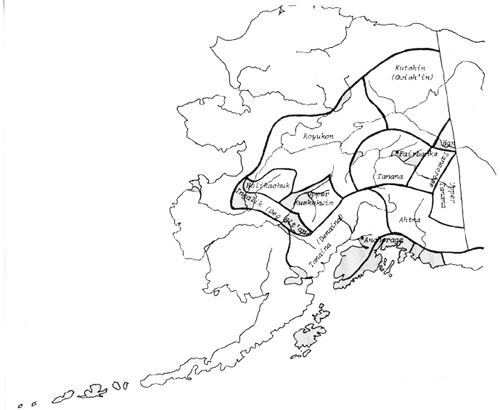
HANDOUT 2
PRONUNCIATION KEY FOR ALASKAN ATHABASCAN LANGUAGE
NAMES
|
Ahtna
|
Ät'nõ
|
|
Han
|
Hän
|
|
Holikachuk
|
Hä'li kõ chuk
|
|
Ingalik(Deg
Hit'an)
|
In gal' ik(Deg' hit
än')
|
|
Koyukon
|
Kö yõ
kän
|
|
Kutchin(Gwich'in)
|
Köö chin'(Gwich
in')
|
|
Tanacross
|
Ta' nõ cräs
|
|
Tanaina (Denaina)
|
Tõ nï' nõ(Dõ nä'
ë nä)
|
|
Tanana
|
Ta' nõ nä
|
|
Upper Kuskokwim
|
Kus' kõ kwim
|
|
Upper Tanana
|
Ta' n∂ nä
|
Pronunciation Key
Ë as in ëven
õ as in "a" in ago
ï as in bïte
ä as in "o" in top
öö as in tool
u as in up
I as in hit
A as in fat
E as in pen
WORKSHEET II
ATHABASCAN TERMS
WORDSEARCH
DIRECTIONS: Find answers to as many of
the following clues in this puzzle as you can. Words may be spelled
frontward, backwards, up and down, or diagonally. The same letters
may be used in more than one word.
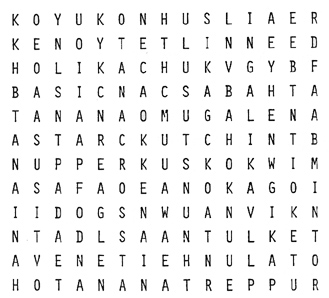
CLUES:
1. The eleven Athabascan languages
2. The Indians of the interior of Alaska are known as
_____________.
3. A ______________ is a requirement which all people share.
4. In fulfilling basic needs from our environment, we ________ to
that environment.
5. Three villages in the Tanaina area.
6. A village in the Upper Tanana area.
7. A village in the Han area.
8. A village in the Kutchin area.
9. A village in the Ingalik area.
10. Three villages in the Koyukon area.
11. A village in the Ahtna area.
12. A village in the Tanana area.
Answer Key
WORKSHEET II
ATHABASCAN TERMS
WORDSEARCH
DIRECTIONS: Find answers to as many of
the following clues in this puzzle as you can. Words may be spelled
frontward, backwards, up and down, or diagonally. The same letters
may be used in more than one word.
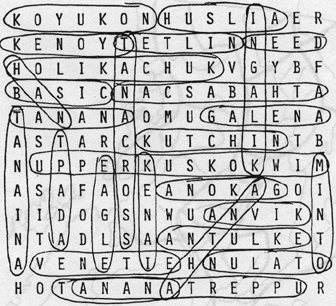
CLUES:
1. The eleven Athabascan languages:
|
Ahtna
|
Han
|
Holikachuk
|
|
Ingalik
|
Koyukon
|
Kutchin
|
|
Tanacross
|
Tanaina
|
Tanana
|
|
Upper
Kuskokwim
|
Upper
Tanana
|
|
2. The Indians of the interior of Alaska
are known as _____Athabascans________.
3. A _____basic need_________ is a
requirement which all people share.
4. In fulfilling basic needs from our
environment, we ____adapt____ to that environment.
- 5. Three villages in the Tanaina
area.
- Eklutna, Tyonek,
Kenai
- 6. A village in the Upper Tanana
area.
- Tetlin
- 7. A village in the Han
area.
- Eagle
- 8. A village in the Kutchin
area.
- Venetie
- 9. A village in the Ingalik
area.
- Anvik
- 10. Three villages in the Koyukon
area.
- Huslia, Nulato,
Galena
- 11. A village in the Ahtna
area.
- Gakona
- 12. A village in the Tanana
area.
- Minto
WORKSHEET III
DIRECTIONS: Label each of the Athabascan
languages shown on this map. You may use the Native Peoples and
Languages of Alaska map as your guide.
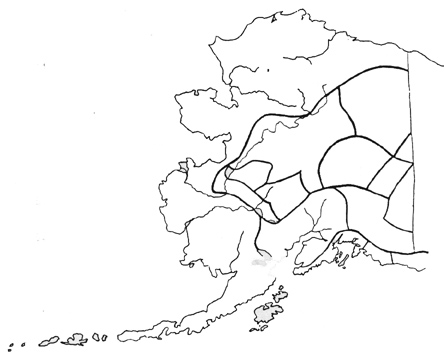
Answer Guide
WORKSHEET III
DIRECTIONS: Label each of the Athabascan
languages shown on this map. You may use the Native Peoples and
Languages of Alaska map as your guide.
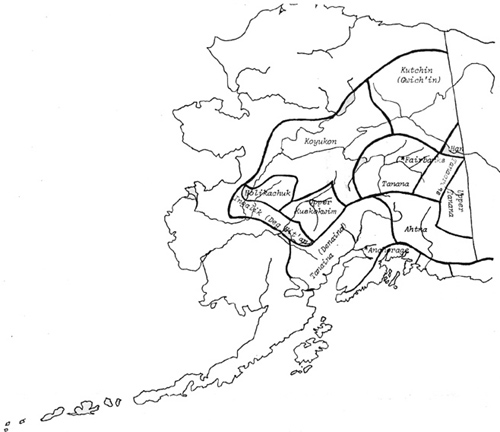
|
Kutchin(Gwich'in)
|
Upper Kuskokwim
|
Han
|
|
Koyukon
|
Tanaina(Dena'ina)
|
Upper Tanana
|
|
Holikachuk
|
Ahtna
|
Tanacross
|
|
Ingalik
|
Tanana
|
|
WORKSHEET IV
TRADITIONAL ATHABASCAN ADAPTATIONS
1. What adaptation did the Athabascans
make to winter traveling needs?
2. What item did the Athabascans value
which traveled hundreds of miles before it reached them?
3. Draw a picture of a kind of basket the
Athabascans used to catch fish.
4. How can you start a fire without a
match?
5. How can you cook food in a birch bark
container without burning it?
6. Nowadays, mothers use plastic infant
seats to carry newborn babies around. What did Athabascan mothers
use?
7. Nowadays this tool is made with a
metal blade; but in the old days, it was made with a blade of a hard,
smooth stone. What is it and what was it used for in the old
days?
8. This weapon was only used by the
bravest men. What was it?
9. What materials were canoes made
of?
10. The bow and arrow were an Athabascan
man's most important weapon. Describe some of the different types of
arrows and how each was used.
11. Although birch bark baskets are still
made today, they are made mostly for beauty, not use. What do you
think serves the same purpose today that birch bark containers used
to serve?
12. Name two methods of hunting that do
not require the hunter to be there.
13. This object got its name from a part
of a fish. Tell what it is and explain how it works.
14. In what Athabascan area was the Hoop
Game played? Explain how it helped prepare boys for
hunting.
15. What are scrapers used
for?
16. What is babiche?
17. Athabascan women, as well as men,
helped obtain food in the old days. Tell which food-getting objects
women used.
18. Which materials did the Athabascans
seem to make most use of in their adaptations, as shown by the
Artifact Cards?
ANSWER GUIDE
WORKSHEET IV
TRADITIONAL ATHABASCAN ADAPTATIONS
- 1. What adaptation did the
Athabascans make to winter traveling needs?
- Snowshoes
-
2. What item did the Athabascans value
which traveled hundreds of miles before it reached
them?
- Dentalium
3. Draw a picture of a kind of basket the
Athabascans used to catch fish.
Picture of fish trap
- 4. How can you start a fire without a
match?
- With a fire/bow drill. An
explanation of how it works can be
included in the answer.
5. How can you cook food in a birch
bark container without burning it?
- By using boiling stones. An
explanation of how they work can be included.
-
6. Nowadays, mothers use plastic
infant seats to carry newborn babies around. What did Athabascan
mothers use?
- Birchbark baby
carriers
-
7. Nowadays this tool is made with a
metal blade; but in the old days, it was made with a blade of a
hard, smooth stone. What is it and what was it used for in the old
days?
- Adze. Used for cutting down trees,
chopping wood, and fashioning
bowls and wooden tools.
-
8. This weapon was only used by the
bravest men. What was it?
- Bear spear
-
9. What materials were canoes made
of?
- Spruce wood for the
frame
- Birch bark for the
cover
Spruce root for the
lashing
- Spruce gum glue for
caulking
-
10. The bow and arrows were an
Athabascan man's most important weapon. Describe sore of the
different types of arrows and how each was used.
- Blunt-headed arrows for small game
or birds
- Long bone arrowheads for
caribou
-
11. Although birch bark baskets are
still made today, they are made mostly for beauty, not use. What
do you think serves the same purpose today that birch bark
containers used to serve?
- Answers will vary. Include paper
bags, buckets, baskets, boxes, trunks, suitcases, jars, cans,
etc.
-
12. Name two methods of hunting that
do not require the hunter to be there.
- Deadfall
- snare
13. This object got its name from a part
of a fish. Tell what it is and explain how it works.
- gill net - when a fish swims into
it, its gills get caught in the mesh.
-
14. In what Athabascan area was the
Hoop Game played? Explain how it helped prepare boys for
hunting.
- Kutchin (or Gwich 'in) area. Boys
had to learn to throw quickly, accurately, and far, all important
skills in using spears in hunting.
-
15. What are scrapers used
for?
- To remove flesh, fat and fur from
a hide so it can be made into a useful item.
-
16. What is babiche?
- Thinly sliced rawhide used in
making snowshoes.
-
17. Athabascan women, as well as men,
helped obtain food in the old days. Tell which food-getting
objects women used.
- Baskets, snares, deadfalls, gill
nets, fish traps
-
18. Which materials did the
Athabascans seem to make most use of in their adaptations, as
shown by the Artifact Cards?
- Birch bark, wood,
roots
- ---Also used, but not in as great
abundance, were bone, stone, leather, sinew, and dentalium
shells.
QUIZ 2
ATHABASCANS
1. Directions: Below is a list of needs
which the Athabascans of the past had. Next to each need are one or
two spaces. In each space, write the adaptation which the Athabascans
made to meet that need. NOTE: Possible answers are given in the list
of words below. In some cases there is more than one adaptation.
Write both down. (60 points)
|
NEED
|
ADAPTATION
|
|
Travel in winter
|
a.
________________________
|
|
Chop wood and split
boards
|
b.
________________________
|
|
Catch food while doing other
Things
|
c.
________________________
|
|
|
d.
________________________
|
|
Practice hunting
skills
|
e.
________________________
|
|
Prepare skins for
clothing
|
f.
________________________
|
|
Catch fish while doing other
things
|
g.
________________________
|
|
|
h.
________________________
|
|
Hold food and
belongings
|
i.
________________________
|
|
Travel in summer
|
j.
________________________
|
|
Carry babies while
traveling
|
k.
________________________
|
|
Start fires
|
l.
________________________
|
|
Hunt animals
|
m.
________________________
|
|
|
n.
________________________
|
|
Cook foods over fires in Bark
containers
|
o.
________________________
|
Choose answers from among
these:
|
Kayak
|
dogsled
|
Throwing board
|
|
Scrapers
|
Boiling stones
|
Hoop game
|
|
Snowshoes
|
Adze
|
Fire drill
|
|
Harpoon
|
Hammock
|
Snare
|
|
Bow and arrows
|
Knife
|
Gill net
|
|
Birch bark baby
carrier
|
Ivory spoons
|
Flint and steel
|
|
Tannic acid
|
Bear spear
|
Sealskin bag
|
|
Birch bark canoe
|
Fish trap
|
Containers(birch bark or
wood)
|
|
Hide and seek
|
halibut hook
|
|
|
Toboggan
|
Deadfall
|
|
- 2. What does the word "Athabascan" mean? (8 points)
- _____A. "Grass here and
there"
- _____B. "People who hunt
caribou"
- _____C. "Those who bask in the
sun"
- _____D. "Land of tall trees and
rivers"
3. The word "Athabascan" refers to
several different things today. For one thing, there is a lake in
Canada named "Lake Athabasca" What else does the word refer to? (8
points)
4. How many Alaskan Athabascan languages
are there? (8 points)
5. Name two Alaskan Athabascan languages.
(16 points)
- a.
- b.
Answer Guide
QUIZ 2
ATHABASCANS
1. Directions: Below is a list of needs
which the Athabascans of the past had. Next to each need are one or
two spaces. In each space, write the adaptation which the Athabascans
made to meet that need. NOTE: Possible answers are given in the list
of words below. In some cases there is more than one adaptation.
Write both down. (60 points)
|
NEED
|
ADAPTATION
|
|
Travel in winter
|
a. ________Snowshoes
|
|
Chop wood and split
boards
|
b. ________Adze
|
|
Catch food while doing other
Things
|
c. ________Deadfall
|
|
|
d. _________Snare
|
|
Practice hunting
skills
|
e. _________Hoop Game
|
|
Prepare skins for
clothing
|
f. _________Scrapers
|
|
Catch fish while doing other
things
|
g. _________Gill Net
|
|
|
h. _________Fish Trap
|
|
Hold food and
belongings
|
i.
__________Containers
|
|
Travel in summer
|
j. __________Birch Bark
Canoe
|
|
Carry babies while
traveling
|
k. ___Birch Bark Baby
Carrier
|
|
Start fires
|
l. __________Fire
Drill
|
|
Hunt animals
|
m. __________Bow and
Arrows
|
|
|
n. __________Bear
Spear
|
|
Cook foods over fires in Bark
containers
|
o. __________Boiling
Stones
|
- 2. What does the word "Athabascan" mean? (8 points)
- __X__A. "Grass here and
there"
- _____B. "People who hunt
caribou"
- _____C. "Those who bask in the
sun"
- _____D. "Land of tall trees and
rivers"
3. The word "Athabascan" refers to
several different things today. For one thing, there is a lake in
Canada named "Lake Athabasca" What else does the word refer to? (8
points)
- The Athabascan language, The
Athabascan Indians, People who lived west of Lake
Athabasca.(Accept any of the above)
4. How many Alaskan Athabascan languages
are there? (8 points)
- Eleven
5. Name two Alaskan Athabascan languages.
(16 points)
- a.Upper Tanana, Tanaina,
Holikachuk, Upper Kuskokwim, Ahtna, Tanana, Hutchin, Han, Inglaik,
Koyukon, Tanacross.
- b.